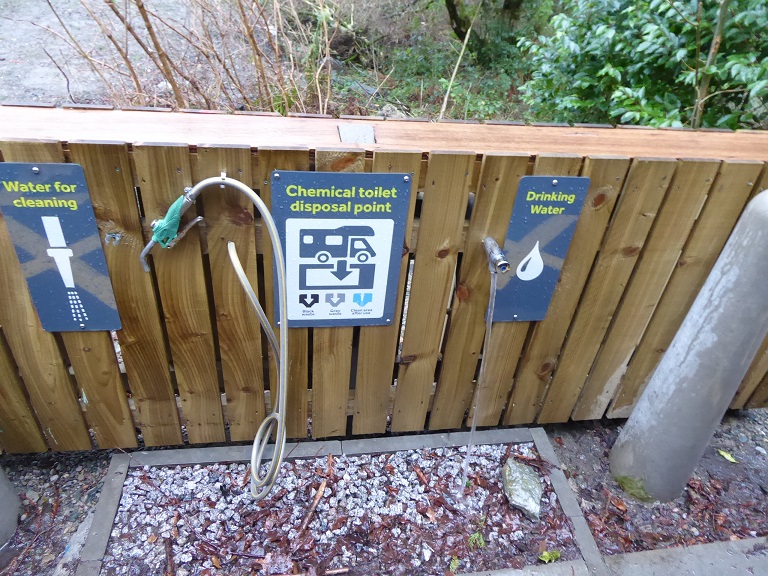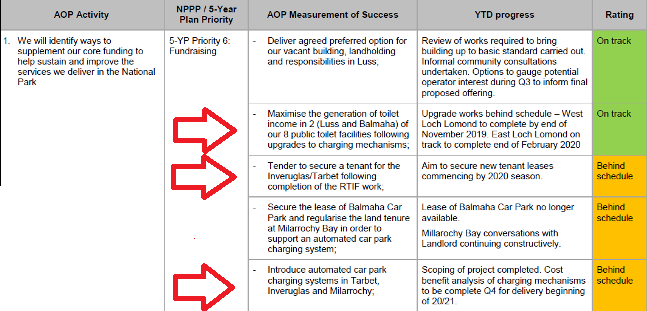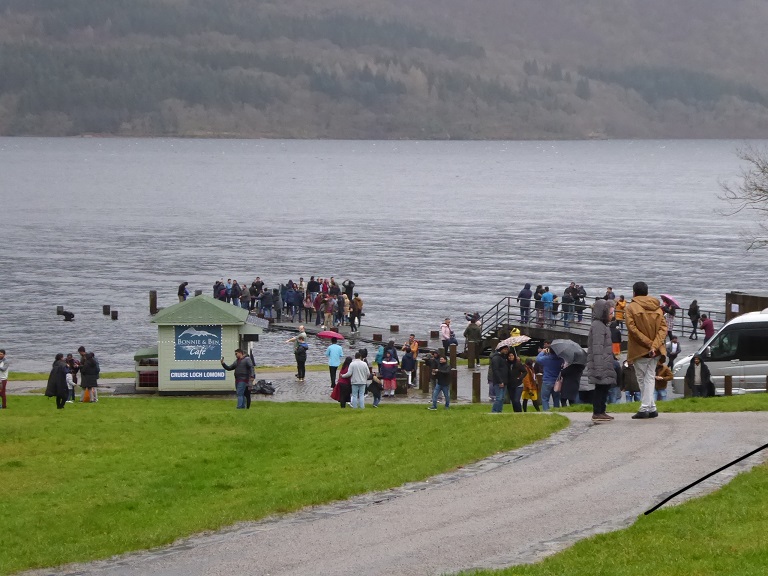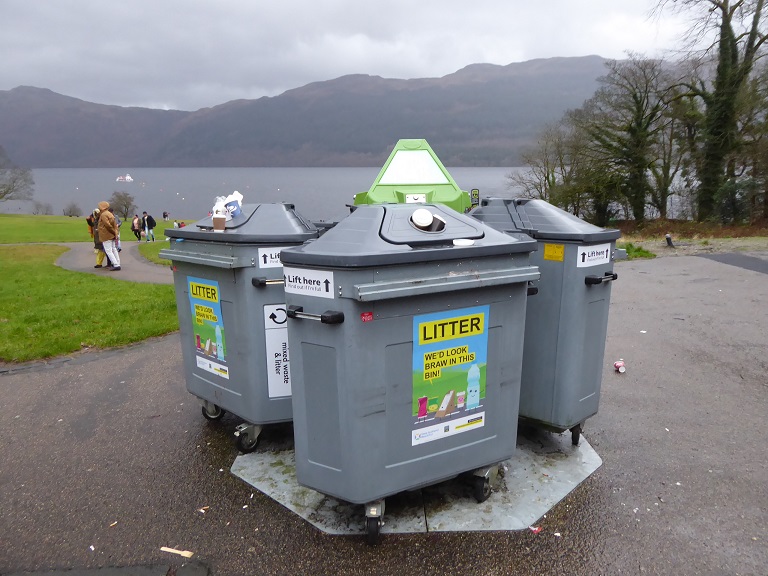
The main investment in new visitor infrastructure that the Loch Lomond and Trossachs National Park Authority has made this year is in upgrading facilities on their land at Tarbet and Inveruglas on the west shore of Loch Lomond.

Tarbet featured in no less than 6 different sections of the Annual Operational Plan Progress Report submitted to the December LLTNPA Board Meeting (see here for paper). On my way north on Saturday, I stopped to take a look for myself.

The creation of a chemical disposal point at Tarbet is extremely welcome. The camping byelaws were intended to apply to campervans – although this has proved impossible to enforce – and should have been accompanied by a major expansion in the provision of new infrastructure. Parkswatch blogged about the dire situation on west Loch Lomond in May 2017 (see here). Two and a half years later – or four years since Scottish Ministers gave the LLTNPA time to prepare for the new byelaws – this is the FIRST example of new campervan provision that the Park has delivered. (The creation of “permit spaces” in car parks and along roads where campervans previously were able to stop for free, which involved a few white lines being painted, shouldn’t count as new infrastructure).
The Rural Tourism Infrastructure fund, created by the Scottish Government, appears to be the main source of funding. This is only half welcome. The Scottish Government has been financially strangling public authorities so almost that all investment, as in this case, is now dependant on grant aid from them. Our National Park are just minor branch offices of the Scottish Government which has been extremely slow to acknowledge the need for investment in new tourist infrastructure across Scotland. Hence the crises on the North Coast 500, Skye etc where tourists, including those in campervans, are overwhelming local facilities and public authorities have no resources with which to respond.
The LLTNPA has – perhaps in return for its punitive actions against campers? – done relatively well financially compared to other public authorities. Its been awarded standstill budgets while the budget for SNH, for example, has been reduced by 40%. It is still, however, dependant on the Scottish Government for all investment. As a consequence its not clear whether a second chemical disposal point, say on the Trossachs side of the National Park, is anywhere on the funding horizon.

Its also welcome that the LLTNPA is making no charge for using the chemical disposal point………..for the time being. There is ample evidence that compulsory charges act as a deterrent and have adverse consequences (just a with litter where charges for waste disposal feed the fly tipping problem).

The free campervan chemical disposal point is, however, out of kilter with the LLTNPA’s general approach to tourist infrastructure which is to instigate charging whereever possible (see above). So far the LLTNPA’s record in trying to charge for facilities has been a miserable failure. Its now three years and four months since the LLTNPA tendered for an Automatic Number Plate Recognition (ANPR) system for Inveruglas, Tarbet and Milarrochy (see here). This was intended to provide a quick source of income for the National Park. Its still classified as being “behind schedule”! The report to the Board also reveals that the plan to introduce an ANPR system at Balmaha have fallen through while a cost-benefit analysis is “to be complete Q4 for delivery beginning of 20/21”. So, why, one might ask was a tender issued in 2016 BEFORE there had been any cost benefit analysis? Why too did the Board at their meeting endorse the new timescales to introduce charges (not a single Board Member questioned the plan) BEFORE they know whether it makes any sense?
Just why the LLTNPA thinks that aiming to “maximise the generation of toilet income” is a worth policy objective for a National Park is unclear, as is why staff are only working to introduce charges at Luss and Balmaha but not at the other 6 toilets we, the public, own?
Small mercies there, plenty of people were using the toilets at Tarbet – although when we dropped in to Inveruglas 10 minutes later the new 24 hour toilets there were locked.

The LLTNPA still seems to be in denial that the tourist season now lasts all year While there is still a high season, there is now a steady stream of people year round, with various tourism peaks. On Saturday the weather on Loch Lomondside was miserable but there were hundreds of people on the publicly owned land at Tarbet. The LLTNPA’s cafe was, however, closed – perhaps as a result of the lease being put out for tender again (see above)?

Given the visitor numbers, it was not surprising to find the bins were overflowing. Whether the smart bins which are being tested will solve the issue is less clear:

While the LLTNPA is belatedly doing some good things at both Tarbet and Inveruglas, their motive for doing doesn’t appear to be because they see it as their mission to serve the public. Rather they see Scottish Government infrastructure funding as an opportunity to raise income to keep themselves going. I doubt this will be successful. The amounts raised are likely to small, even if the LLTNPA follows the example of Argyll and Bute Council at Arrochar (see here), and the unintended adverse consequences are likely to be significant. The LLTNPA would be far better to drop its plan for this hotch potch of charges and return to its fundamental principles which are about serving the public, local communities and the natural environment.
There are, however, other factors going on at Tarbet. The LLTNPA’s land, where the newly upgraded parking area, cafe and chemical disposal point are located, has been included in Moulsdale Properties new development proposals for Tarbet (see here). The LLTNPA Board should have discussed whether they would agree to allow public land to be used by a private developer BEFORE any new investment in their property went ahead. By failing to do so the LLTNPA appears once again – as they did with Flamingo Land (see here) – to be putting the interests of private developers before the public interest.

If the LLTNPA are spending money in up grading perhaps they could put in lights round the Duncan Mills Slipway for health and safety before some one is hurt
Scotland’s national park budgets are constantly undermined. Could it be that Scottish ministers see it as their primary duty to oversee all aspects of national life where they can be praised, but are left with too little time to oversee long term policy issues? Failures – regarding SNH and Scottish forestry; failure regarding oversight of countryside planning issues; negligence over oversight of regional Policing, and now the manner in which Scotland’s public spaces and parks are funded – become too clear. Policy in each area could be modified. Each of these issues represent examples where any failure to perform has been “skillfully” “outsourced” ( wonderful, jargon that ! ) to another “statutory” authority, and ministers can ‘pass the buck’ while keeping their own reputations intact?
There are two truths that leap from the present hand’s off approach to National Park funding . First, every single visitor to Scotland is a potential source of income to local and national business. Each will also contribute through general taxation in every purchase they make, everyday, while on Holiday in Scotland. ( They might choose to go anywhere in the world – if they did, Scotland would get nothing from them.). The second is that proper parking facilities, lay-bys and camping spots near attractions are essential to encourage visitors to stop and stay long enough to spend. It has to be recognised that ..in the round..visitors to Scotland are not an expense. The simple presence of them across Scotland becomes an asset to the exchequer every time they open their wallets. It is hard to believe any local authority, including the National park boards ever pause to consider how many visitors always will drive on whenever there is a charge to park or to camp. ( I am one and yet pay residential rates in Scotland. ) The first principle of being visitor friendly overrides everything. Adequate central funding for the National parks, not piecemeal monitoring and wholesale “fleecing” of everyone silly enough to stop in a public place is the wiser approach.
More than no services for campervans is very welcome. But it’s so far behind the rest of Europe, where this form of leisure activity is also very popular. Campervan sales continue to rise strongly. In France, which has always led the way, public Aires are common. But there’s an interesting new development that might be of interest to the LLTNPA. A private company had been taking over public Aires and running them for the community… sharing the profits and publicising discounts offered by local businesses, maintaining the facilities and managing all the marketing. See https://campingcarpark.com/en/ they’ve also been investing in lots of new facilities. Seems like an ideal model for the Highlands.
Hi Andrew, interesting – there was an opportunity at Tarbet and Inveruglas to support the Arrochar and Tarbet Community Development Trust to take over management of both cafes in LLTNPA owned property but instead the LLTNPA appears to be tendering for new tenants.
I have to confess to being bewildered by the support shown for motorhomes, and the right to almost unrestricted free overnight parking, and the provision of free facilities. One has to ask if these ponderous, obstructing vehicles and their occupants contribute very much at all to the local economy in the Highlands and Islands. I logged into a website for motorhome drivers for a few days, and the main obsession seems to be where you can get a free doss for the night. Am I caricaturing to say that the main spend will be fuel and food, inevitably stocked up in a big national or international supermarket in say Inverness, with only a small spend in local shops, and little spent on camp site fees or meals out, ie supporting local businesses. The situation that obtained on the Glendale to Neist road on Skye last summer would be a farce, but it is not funny to have a road blocked for a day by inconsiderate and incompetent drivers of over large vehicles. I have a friend who reports having to negotiate a situation on Mull when one of them was blocking a school bus on a home run, and refusing or being incapable of reversing. I think we could see more direct action by locals on Skye and other hotspots against these vehicles. I am not sure if the system can absorb many more of them, but if facilities are to be provided it should be on designated sites. And for goodness sake, these vehicles are hugely expensive. The occupants are not poor and can easily pay for facilities like other campers, campervanners and caravanners. Comparisons with the Aires on French motorways are not relevant. When you get to your holiday destination, off the motorway, you really have to go on a paying camp site. Often, in France, run by the local commune. Unfortunately no such thing as “Camping Municipal” in this country. There are other issues to consider too. If as another correspondent says there are scheduled to be far more of these vehicles in the future, then northern roads will not be able to cope. And these vehicles generally give poor mileage, usually burning large volumes of diesel to move just two people about in most cases. There is no case for National Parks to subsidise them.
There is a lot of criticism leveled at visitors who now choose to tour Scotland by camping van.( A few years ago these people might have occupied the numerous caravans dotted on crofts across the Highlands?) But technology has moved on. National legislation should indeed be mobilised . Too many who have passed a car test have no idea about the responsibilities required of those who drive larger vehicles. Many modern Camping vans, loaded up while on tour today, would breach the 3500kg gross limit for those who qualified to drive after January 1997. The law surrounding hire of vehicles should address this . Many communities around Scotland are investing to provide additional stopping places for these vans. Popular press reports too frequently suggest otherwise. The need for yet more investment by Community groups and local companies is not questioned. However the ranks of vans seen in early september thronging facilities at John O Groats, at Durness, Near Gairloch, Ullapool and at Applecross does suggest that when any community invests,as many have around NC500, the rewards can be substantial. providing areas to stop and getting the vans to linger somewhere they enjoy, is key to this. Only then can shops, bars, restaurants, garages and fuel stations – and all the staff employed by them- all benefit. As Phil observes Scotland needs to study this. Franchises like the Top Ten Camps concept ( NZ) have operated for decades . At present open competition exists between each Scottish camp operator. The bigger picture of a federation of cooperatives all offering high class pitches at locations spaced all across Scotland has not been adopted .Once again , the secret lies in welcoming those on the move, not placing barriers real and fiscal, that force them back out onto highways, hoping against hope for some free space to pause again as they for ever move on.
You’re completely right Tom… motorhomes are rapidly increasing in popularity. Scotland can recognise this as an opportunity, or turn its collective back and just complain.
Motorhomes are… mobile. Their owners relatively affluent. Encourage them with good facilities and they’ll be great visitors in return. Many other countries have learnt this.
Re motorhome rental… I do tend to agree that more (any) regulation is needed here. There are no rules on any prior training required for the inexperienced, guidance on overloading etc. An owner rapidly develops this essential knowledge but I worry about first timers being launched on to our roads with little knowledge, by the less scrupulous hire companies.
Scotland needs to develop Aires as in France. There are over 4000 across France with many small villages having one to encourage people to shop and eat locally. (Motorway aires are a different thing) Self contained campervans and motorhomes do not require campsites, just disposal points and somewhere to park up for the night. We regularly spend a month or so in France on aires that are either free or a couple of Euros and spend money in local businesses. We do use campsites if we wish to spend more than one night in a village. Toilet waste is always free to dispose of to prevent problems. Some french villages even provide free electricity!
Aires would also help with managing the rental market.
Unfortunately ‘Phil’ I feel that somebody with a limited I.Q has hijacked your account!